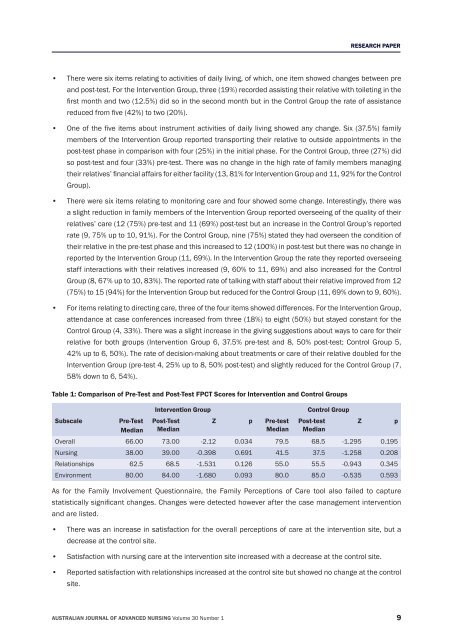Download Complete Issue - Australian Journal of Advanced Nursing
Download Complete Issue - Australian Journal of Advanced Nursing
Download Complete Issue - Australian Journal of Advanced Nursing
Create successful ePaper yourself
Turn your PDF publications into a flip-book with our unique Google optimized e-Paper software.
RESEARCH PAPER<br />
• There were six items relating to activities <strong>of</strong> daily living, <strong>of</strong> which, one item showed changes between pre<br />
and post‐test. For the Intervention Group, three (19%) recorded assisting their relative with toileting in the<br />
first month and two (12.5%) did so in the second month but in the Control Group the rate <strong>of</strong> assistance<br />
reduced from five (42%) to two (20%).<br />
• One <strong>of</strong> the five items about instrument activities <strong>of</strong> daily living showed any change. Six (37.5%) family<br />
members <strong>of</strong> the Intervention Group reported transporting their relative to outside appointments in the<br />
post‐test phase in comparison with four (25%) in the initial phase. For the Control Group, three (27%) did<br />
so post‐test and four (33%) pre‐test. There was no change in the high rate <strong>of</strong> family members managing<br />
their relatives’ financial affairs for either facility (13, 81% for Intervention Group and 11, 92% for the Control<br />
Group).<br />
• There were six items relating to monitoring care and four showed some change. Interestingly, there was<br />
a slight reduction in family members <strong>of</strong> the Intervention Group reported overseeing <strong>of</strong> the quality <strong>of</strong> their<br />
relatives’ care (12 (75%) pre‐test and 11 (69%) post‐test but an increase in the Control Group’s reported<br />
rate (9, 75% up to 10, 91%). For the Control Group, nine (75%) stated they had overseen the condition <strong>of</strong><br />
their relative in the pre‐test phase and this increased to 12 (100%) in post‐test but there was no change in<br />
reported by the Intervention Group (11, 69%). In the Intervention Group the rate they reported overseeing<br />
staff interactions with their relatives increased (9, 60% to 11, 69%) and also increased for the Control<br />
Group (8, 67% up to 10, 83%). The reported rate <strong>of</strong> talking with staff about their relative improved from 12<br />
(75%) to 15 (94%) for the Intervention Group but reduced for the Control Group (11, 69% down to 9, 60%).<br />
• For items relating to directing care, three <strong>of</strong> the four items showed differences. For the Intervention Group,<br />
attendance at case conferences increased from three (18%) to eight (50%) but stayed constant for the<br />
Control Group (4, 33%). There was a slight increase in the giving suggestions about ways to care for their<br />
relative for both groups (Intervention Group 6, 37.5% pre‐test and 8, 50% post‐test; Control Group 5,<br />
42% up to 6, 50%). The rate <strong>of</strong> decision‐making about treatments or care <strong>of</strong> their relative doubled for the<br />
Intervention Group (pre‐test 4, 25% up to 8, 50% post‐test) and slightly reduced for the Control Group (7,<br />
58% down to 6, 54%).<br />
Table 1: Comparison <strong>of</strong> Pre‐Test and Post‐Test FPCT Scores for Intervention and Control Groups<br />
Subscale<br />
Pre‐Test<br />
Median<br />
Intervention Group<br />
Post‐Test<br />
Median<br />
Z p Pre‐test<br />
Median<br />
Control Group<br />
Post‐test<br />
Median<br />
Overall 66.00 73.00 ‐2.12 0.034 79.5 68.5 ‐1.295 0.195<br />
<strong>Nursing</strong> 38.00 39.00 ‐0.398 0.691 41.5 37.5 ‐1.258 0.208<br />
Relationships 62.5 68.5 ‐1.531 0.126 55.0 55.5 ‐0.943 0.345<br />
Environment 80.00 84.00 ‐1.680 0.093 80.0 85.0 ‐0.535 0.593<br />
As for the Family Involvement Questionnaire, the Family Perceptions <strong>of</strong> Care tool also failed to capture<br />
statistically significant changes. Changes were detected however after the case management intervention<br />
and are listed.<br />
• There was an increase in satisfaction for the overall perceptions <strong>of</strong> care at the intervention site, but a<br />
decrease at the control site.<br />
• Satisfaction with nursing care at the intervention site increased with a decrease at the control site.<br />
• Reported satisfaction with relationships increased at the control site but showed no change at the control<br />
site.<br />
Z<br />
p<br />
AUSTRALIAN JOURNAL OF ADVANCED NURSING Volume 30 Number 1 9

















